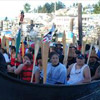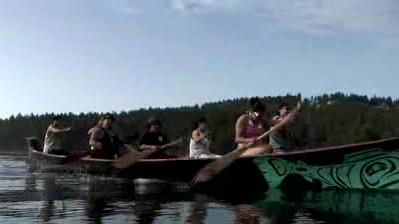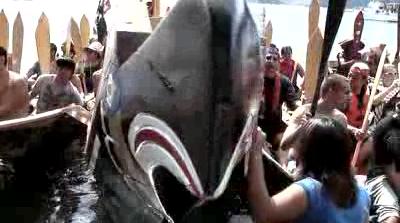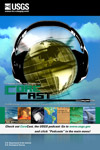USGS CoreCast
USGS Podcasts Home > CoreCast Home Page
Can't see Flash? Install Flash Player.
|
61
|

The USGS and the Coast Salish Tribal Nation have partnered during the annual Tribal Canoe Journey to study and help improve resources of the Salish Sea. This final episode in the Corecast Tribal Journey gives an overview of the journey, including a look at preliminary results and additional short video clips and commentary as they paddle through the San Juan Islands and British Columbia (in the Transcript section). Play Video: (downloading may take some time due to file sizes)
Type: video/mp4
File Size: 45033150 bytes Duration: 6:41 Released: Tue, 19 Aug 2008 13:34:09 UTC |
Transcript:
Jennifer LaVista: Welcome, and thanks for tuning in to a special Tribal Journey edition of CoreCast. I'm Jennifer LaVista. This is the final day of the 2008 Coast Salish Tribal Journey and over 100 canoes are landing here in Quw'utsun, British Colombia. Five of which are carrying water-quality probes as part of the US Geological Survey and Coast Salish Nation Partnership. Let's check out what has happened over the past few days. Speaker 1: It was an amazing journey. Six days on the water paddling through different types of water bodies, beautiful islands. Got to witness the kids looking out of their environment, it was great. Speaker 2: The Tribal Journey is an event that is held every year and it travels to different locations throughout the Salish Sea. Speaker 3: We come together once a year to celebrate and to work on things that we think are important to the environtment. Speaker 2: We live in an amazing eco-region and interestingly enough it has one aboriginal group that inhabits that area and that is the Coast Salish people. Their cultures rely on the resources of the Salish Sea. And those resources are diminishing and are threatened. Speaker 1: The Salmon Dancer is the canoe that we purchased this year and it carries approximately 40 paddlers fully loaded. We are salmon people. We have for thousands of years been able to sustain ourselves on salmon and we were able to do that year-round. Unfortunately, there has been a rapid decline in the salmon over the last 30, 40, or 50 years. The Coast Salish gathering in Tulalip we unanimously voted to team up with USGS and allow them to participate in our canoe journey this year. |
|||||
| 02:06 |
Jennifer LaVista: So, before the journey we trained five technicians to take this water-quality probes on the canoes and that entailed teaching them how to calibrate and audit the probes, set up files, make sure that the equipment is functioning properly and was maintained along the way. Speaker 1: We are just hopeful that during the first year we would get the logistics ironed out, the equipment working, test the idea of having multiple probes on different canoes or cross such a large area in operation and collecting data and that seem to work pretty well. Jennifer LaVista: During the journey I would take the technicians to their respective families and see them off in the morning, and welcome them back in the evening, download the data, process it a little bit and send it off to Ray Julich from the Tacoma office to send it on to the website. |
||||
| 03:03 |
Speaker 1: What is phenomenal about this is that the readings that we are getting out of this equiptment is possible because it's being pulled behind canoes where there is no engine prop or gas or this or anything distributing the equipment. And we have this partnership that was created that is allowing us not only to have information that we need but the whole world needs to see. This will be information that people around the world will say, "Wow cool, let's do that too!" Speaker 3: It's a little early to talk too much in detail about the results but we did look at some of the first few days of the journey up through the Southern Puget Sound and Hood Canal, and across the San Juan Islands. And there is a few interesting preliminary results. Hood Canal was quite warm. We measured water temperatures upwards of 71 degrees fairly early in the morning, 8:30 in the morning after several days of gloomy cloudy weather like this. That points to an interest to examine that further. I did also a lot of jellyfish in Hood Canal relative to the other areas that we paddled through. Often, but not always, a lot of jellyfish are indicative of poor water quality conditions. They're the last ones to thrive in those kind of conditions. Trying to engage some of the local folks in terms of what they've known about the environment to compare what we're finding in this trip. A group of us will get together possibly with members of different Coast Salish groups and look at the results, talk about them, compare them to what they understand the system to be. |
||||
| 04:49 |
Speaker 2: These people have been here for literally 10,000 years. If you talk to some of the elders they will tell you, "We know what this place is, but you never ask us about it." And so, i think this is an opportunity to blend those two traditions and to really put the spotlight on the issues in the Salish Sea and the value of the traditional people who live here. |
||||
| 05:17 |
Speaker 1: It's a great partnership that we have created and I hope we continue to do it year after year, after year. Speaker 2: Funding has really come from several sources. USGS has provided not only technical assistance, but funding for the equipment. The Northwest Straits Commision provided funding for the technicians. The Potlatch Foundation provided a small amount of disretionary money. And then the Swinomish Tribe of course has provided a lot of resources, time and equipment et cetera to the effort. |
||||
| 06:00 |
Speaker 1: We know what has happened in the last 150 years and you just look around you and you see that everything has been degraded and so our goal it to try to make the Salish Sea something that our children and grandchildren and seven generations down the way will be proud of it and something hopefully that we will leave them in better shape than what we have received then. Jennifer LaVista: Log on usgs.gov/coastsalish for upcoming reports and analysis over the next few months. CoreCast is a product of the U.S. Geological Survey, Department of the Interior. Until next time, I'm Jennifer LaVista. |
Read more information about the USGS and Coast Salish partnership.




